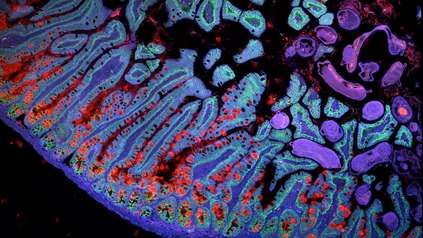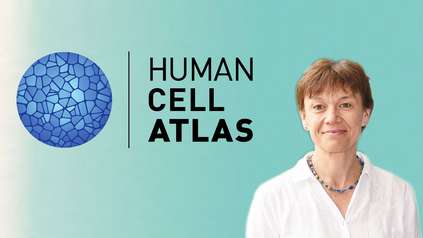Explore COVID-19 science in action with new Human Cell Atlas animation
A new animation has been created for secondary school students to explore how the SARS-CoV-2 coronavirus responsible for COVID-19 works, and how the Human Cell Atlas (HCA) consortium is mapping how the virus interacts with the human body.
This arts and science collaboration between the Wellcome Sanger Institute and University of Sunderland gives an accessible introduction to the biology of COVID-19 to students and the general public. It also highlights recent findings from the global HCA consortium that identified specific nose and eye cells that could be involved in transmission of the SARS-CoV-2 virus.
The Human Cell Atlas (HCA) is a pioneering, multidisciplinary global research project that aims to create a ‘Google map’ of all 37 trillion cells in the human body. This map is paving the way for a new understanding of human health and disease.
As the global COVID-19 pandemic started, HCA researchers from around the world quickly came together to find out how the coronavirus responsible for COVID-19 affects cells. They discovered that cells in the nose and eyes have entry points for the virus, making them likely initial infection routes. This global research is continuing rapidly, to help understand how the virus works.
The public engagement animation, entitled: ‘Mapping COVID-19: How the Human Cell Atlas enhances our understanding of the disease’ was created for students aged 11-14, Funded by Wellcome as part of their Strategic Science Award to the HCA, it shows our rapidly growing understanding of how COVID-19 is transmitted and reveals the impact of scientific research on real-world problems.
“We hope that teachers and educators can use our animation as a resource to explain the biology of COVID-19 in an engaging way. At University of Sunderland, we’re committed to developing interdisciplinary opportunities that help show our students how well arts and diverse disciplines can complement each other. Our animation shows how creative skills can develop a deeper understanding of how cutting edge science is applied in the real world, bringing science to light.”
Nick Lewis, Lecturer in Illustration, Animation and Games Art at University of Sunderland
The cross-disciplinary collaboration is a great example of the power of STEAM – Science Technology Engineering Arts and Maths. This arts and science collaboration was also supported by Wellcome Genome Campus Public Engagement.
“This is the first arts-science collaboration in our ambitious public engagement programme with the Human Cell Atlas, and we hope this animation will engage the general public as well as school students. Our aim is to improve the value and trust people place in pioneering scientific research by fostering opportunities to develop new ways of thinking, seeing and doing between artists, scientists and diverse communities across the UK and beyond.”
Suzy O’Hara, Project Manager and Curator of the Human Cell Atlas Public Engagement Wellcome Grant, working on behalf of the Wellcome Sanger Institute
“The Human Cell Atlas is aiming to map every cell type in the human body. Even as we’re building the Atlas, it is already being used to understand COVID-19 and identify which cells are critical for initial infection and transmission, which could help understand how coronavirus spreads. This animation introduces the idea of the Human Cell Atlas research and shows students how science is directly helping to understand the COVID-19 pandemic and respond to it.”
Dr Sarah Teichmann from the Wellcome Sanger Institute and co-chair of the Human Cell Atlas Organising Committee
Teachers and anyone else who is interested can watch the video and sign up for information on future HCA Public Engagement images and animations at: https://www.humancellatlas.org/engagement/
More information
Animation:
‘Mapping COVID-19: How the Human Cell Atlas enhances our understanding of the disease’ at https://www.humancellatlas.org/engagement/
The Human Cell Atlas:
The Human Cell Atlas (HCA) is an international collaborative consortium, which aims to create comprehensive reference maps of all human cells—the fundamental units of life—as a basis for both understanding human health and diagnosing, monitoring, and treating disease. The HCA is steered and governed by an Organising Committee, which is co-chaired by Dr Sarah Teichmann of the Wellcome Sanger Institute (UK), and Dr Aviv Regev of the Broad Institute of MIT and Harvard (USA). https://www.humancellatlas.org
Further HCA research on COVID-19 at:
https://www.humancellatlas.org/covid-19/
Press release about the finding:
https://www.sanger.ac.uk/news_item/key-nose-cells-identified-as-likely-covid-19-entry-points/
Publication that revealed the cell types in the nose:
Waradon Sungnak et al. (2020) Single-Cell Transcriptomics Data Survey Reveals SARS-CoV-2 Entry Factors Highly Expressed in Nasal Epithelial Cells Together with Innate Immune Genes. Nature Medicine. DOI: 10.1038/s41591-020-0868-6
Funding:
This was funded by Wellcome, through their HCA public engagement award 218597/Z/19/Z
Selected websites
About the University of Sunderland
The University of Sunderland welcomes all with talent into higher education and supports them in reaching their potential.
The University has 20,000 students based at campuses in Sunderland, London and Hong Kong, as well as with global learning partnerships in 15 countries. Working to shape the city and region, the University is proud of its positive contribution to economic and social change. Its graduates leave equipped with the knowledge, skills, confidence and connections to make a positive difference in the wider world. Find out how the University of Sunderland can change lives at www.sunderland.ac.uk
About Wellcome Genome Campus Public Engagement
Wellcome Genome Campus Public Engagement’s ambition is to build a world-leading engaged research campus by supporting and empowering the Wellcome Genome Campus community to develop relationships across a range of different audiences. We do this through a varied programme of support, mentoring and the creation of live and digital experiences. https://publicengagement.wellcomegenomecampus.org/
Wellcome Sanger Institute
The Wellcome Sanger Institute is a world leading genomics research centre. We undertake large-scale research that forms the foundations of knowledge in biology and medicine. We are open and collaborative; our data, results, tools and technologies are shared across the globe to advance science. Our ambition is vast – we take on projects that are not possible anywhere else. We use the power of genome sequencing to understand and harness the information in DNA. Funded by Wellcome, we have the freedom and support to push the boundaries of genomics. Our findings are used to improve health and to understand life on Earth. Find out more at www.sanger.ac.uk or follow us on Twitter, Facebook, LinkedIn and on our Blog.
About Wellcome
Wellcome exists to improve health by helping great ideas to thrive. We support researchers, we take on big health challenges, we campaign for better science, and we help everyone get involved with science and health research. We are a politically and financially independent foundation. https://wellcome.org/





